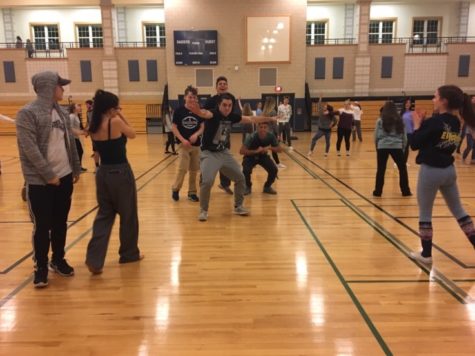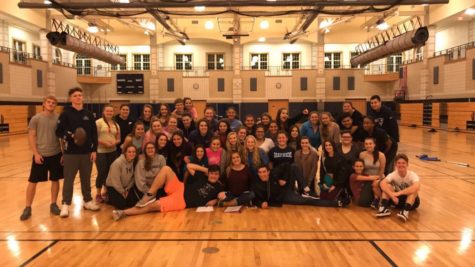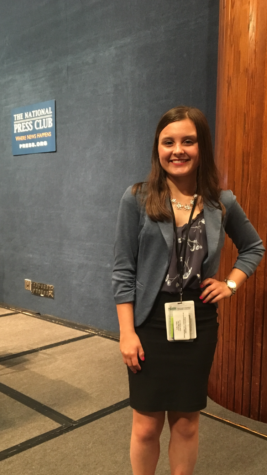Behind the Scenes of Case Rally
November 26, 2017
Every year, the entirety of Somerset Berkley Regional High School and many Somerset residents gather in a pep rally celebration that prepares the school to face its arch rival, Case High School, in the annual Thanksgiving Day football game. But what really goes on in the month of preparation for Case Rally?
“The most stressful part is making sure everything is done in time. We’re responsible for a lot in not a lot of time,” the senior class president, Kara Kanuse, says. “You want to make everyone happy but at the same time it’s hard when you don’t get a lot of help.”
On Case Rally day, each grade performs a skit in front of the school in the order that follows: juniors, freshmen, sophomores, seniors. Students usually use a movie or TV show to base their script, art, dancing, music selection, and acting off of.
Each grade competes for first place. This year, the freshmen are doing Mario Kart, the sophomores are doing Scooby-Doo, the juniors are doing Aladdin, and the seniors are doing Peter Pan.
The skits are judged by a panel of five teachers. Each grade has the ability to choose two of their judges. Each grade is also advised by at least one teacher during the preparation period.
One feature of Case Rally is Penny Pounds, in which each grade fundraises money for a cause. The grade that raises the most Penny Pounds gets a small advantage over the other classes. Classes cannot start collecting Penny Pounds until November 1. This year, fundraising techniques have included car washes, selling lanyards and raffle tickets, and in-school canning.
Typically, the planning for Case Rally begins right after the class presidents are elected around mid-October. However, junior class president Ryan Silverman says that people were already beginning to think about themes as soon as last year’s Case Rally was finished.
“But it’s kind of hard to start on Case Rally stuff when you don’t have an official leader,” Silverman says.
Kanuse has been involved in Case Rally throughout her four years at SBRHS. This year, she is Wendy in the senior’s Peter Pan skit. Silverman was involved in Case Rally last year and this year.
This year, the senior class has about 40 people involved in Case Rally while the junior class has around 50.
Kanuse says that her grade’s strategy for winning Case Rally this year is “a lot of time management and planning, making sure everyone’s organized and has a role and knows what they’re doing.”

“My strategy is finding the people who are good at art, music, dancing, and acting, making them in charge, and letting them do it because they have skills that I do not. I’m just the organizer,” Silverman says.
As the organizer, Silverman makes sure that each person that is in charge of the different topics is keeping on top of things.
This year, both the juniors and seniors have Google Classrooms where they are able to post electronic notifications that everyone involved in the skit can see or respond to.
“My role is to make sure everything gets done. I do a lot of delegating, and I have about five main people that help me out a lot,” Kanuse says. “I just make sure that art has everything done, music is done, and the script is written and approved by the principal, Mr. Lanczycki.”
The first step of Case Rally preparation is choosing an idea for a skit.
The seniors had a meeting and voted on what idea they would want for a skit by sending their ideas in a text message to one of the senior student council members. The seniors then “SOAPSTone” (Subject, Occasion, Audience, Purpose, Speaker, Tone) the idea to see if it would be a good skit topic.
“We try to think about who we’re performing the skit for, so we try to make it funny for the students but we also need to make sure that we’re targeting the teachers who are the judges,” Kanuse says.
Some ideas that the seniors considered using but never made it past the cutting board include Star Wars, The Breakfast Club, and Harry Potter.
On the other hand, Silverman sent out an electronic form to the junior class so the people that wanted to get involved in the skit could. One of the things on this form was a question asking for skit ideas. After the forms were submitted, Silverman compiled a list of the ideas that were most frequently mentioned and then those ideas were voted on at a meeting.
Originally, the juniors picked Peter Pan as their skit idea but the senior class decided on the same idea. Because the choosing of ideas goes by seniority, the seniors got Peter Pan and the juniors were forced to choose another idea.
“We were really in a crunch to get a theme so we could get started, so I had to send out another Google Form with what the theme would be,” Silverman says.
Eventually, Aladdin was decided.
Some of the skit ideas the juniors thought about but never decided upon are Snow White and Ghostbusters.
Silverman says that the key to a good Case Rally idea is that “you have a solid plot line with a lot of characters. This year, I think the freshmen are going to have a lot of trouble with their skit because their theme doesn’t have a solid plot line.”
He says his class had a similar problem when they were freshmen and did Ellen for a skit idea.
After an idea is chosen, each grade goes to work preparing their skit.
A small group of writers work on the script, the main characters are casted, the music is selected, dances are choreographed, and the skit is rehearsed.
In past years, a lot of the music is performed live by members of the grade’s pit band. In recent years, live singing has also been introduced.
Often times in the dances, anyone who wants to participate is able to do so. However, there is typically a select dance in different Case Rally skits. The purpose of the select dance, where the participating dancers are chosen by the choreographers, is to make the dance look better than the big group dances, therefore earning a higher score.
Typically each grade level has scheduled time to rehearse their Case Rally skit in the school’s gym, where the skit is performed on Case Rally day. However, the classes also schedule meetings after school and during the weekends wherever they can find practice space. Usually Case Rally practices are a couple of times per week until the date draws closer and practices happen everyday. Practices usually range anywhere from two hours to four or more hours.
Closer to the Case Rally date, each class president meets with Lanzcycki to make sure that the script is appropriate. Shortly before Case Rally, each grade does a dress rehearsal of their skit in front of Lanzcycki.
Kanuse jokes that the night before Case Rally usually consists of “a lot of tears, ice cream, some more tears, and running to Walmart to get all that last minute stuff.”
Silverman says that, in general, the most stressful part about Case Rally is “just making sure you get things done quick enough so other things can get done.”

Tensions are high this year between the junior and senior classes, since the juniors beat this year’s seniors last year at Case Rally. While the juniors are preparing for another win this year, the seniors are hoping for a chance at redemption.
Silverman says that one advantage his class has is that they have “a lot more organization than the senior class, and I truly believe that organization is the key thing that makes or breaks pretty much anything.”
Kanuse says that usually the seniors get to sell class t-shirts for a Penny Pound profit, but that privilege was taken away this year, so she does not consider them to have any advantages anymore.
Silverman thinks that a Case Rally skit is successful if people seem to look like they know what they’re doing. He says that classes are much better off going for something simple that everyone can do instead of going for something complicated that only a few people can do.
Kanuse says that a skit is successful if everyone comes together as a class and is able to enjoy themselves.
Because Case Rally is so stressful, Kanuse states that her favorite part is when it is over.
The results of this year’s Case Rally were, from first to last, juniors, seniors, sophomores, freshmen.
Silverman says that his favorite part is “seeing the final product and just seeing how talented different people are in my grade. Seeing the artwork and the dancers and our pit band and, this year, the Color Guard is great because they’re all amazing and it’s great to see people come together as a class.”


